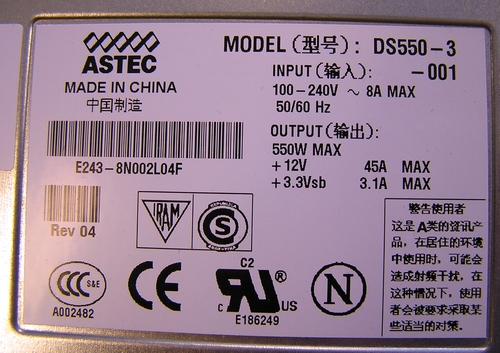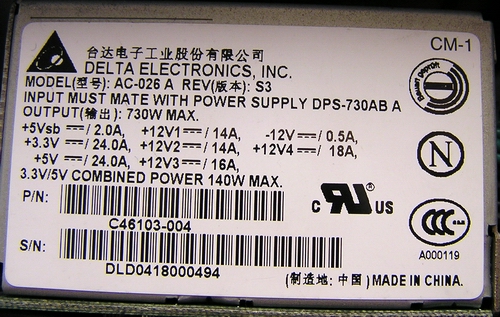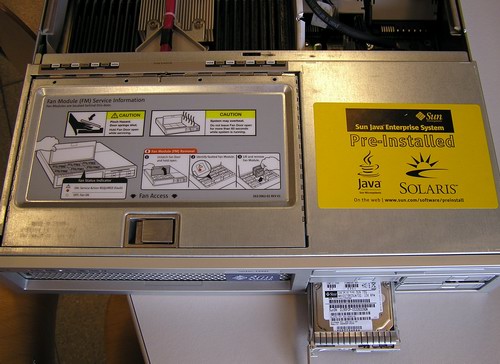Sun’s T2000 “Coolthreads” Server: First Impressions and Experiences
by Johan De Gelas on March 24, 2006 12:05 AM EST- Posted in
- IT Computing
Power
Superb Performance/Watt is what Sun promises with its Coolthreads T2000 server. However, the current T2000 still consumes a bit more power than what they necessarily need. For example, for logistical efficiency reasons, Sun uses a 550 Watt power supply that is also used in the Sun's Galaxy Opteron servers. That power supply will be replaced by a 400-450W more power efficient one later on.
This is the power supply that we used on the Xeon.
The big loser here is, as expected, the Intel Xeon server. The T1 outperformed the dual Xeon 3.6 GHz with a decent, even significant margin and consumes about half the power of the Xeon machine. Add to this that a more efficient 450 Watt power supply will lower the power by another 30 to 40 Watt for the T2000.
The other winner is, of course, the Opteron HE. This CPU could also be used with a more efficient and lower peak power power supply. An Opteron HE is the best x86 alternative for the Sun UltraSparc T1, but fortunately for Sun, this CPU has not yet been picked up by a big OEM like HP or IBM.
First impressions so far
Even if we assume that the exceptional Spec Web 2005 and JBB 2005 numbers, which Sun posted are too optimistic, our own power measurements confirm that the T2000 is much more than yet another Sun Server.
At first sight, Sun has won the performance/watt battle for now, but it cannot rest on its laurels. Low voltage versions of the Xeon "Woodcrest" (Core architecture) and Opteron might be able to come very close to the performance/Watt levels that the T1 offers. Our first impression is also that Sun still has a lot of room for improvement - better power supplies and power management - and it can continue to outperform the x86 servers by a decent to large margin when it comes to performance per Watt.
We also can't shake the feeling that the number of applications, which will really exhibit the kind of exceptional performance that Sun's own heavily optimised benchmarks show, will be quite limited. A slightly annoying issue is indeed the fact that relatively low amounts of FP instructions in your applications may lower the performance of your T2000 significantly. We are not talking about heavy HPC FP crunching applications, but server apps with a bit of FP calculations here and there. Contrary to other servers, 1.5-2% of FP instructions might be enough to make your application less suitable for the T2000. And profiling your applications in depth is not something that all administrators can or like to do. Sun seems to agree quietly, and is very busy with the T2 (Niagara 2), which has one FPU per core.
The price, about $13000 for the tested server (with 8 GB), seems a bit higher than a typical x86 server, even when equipped with redundant power supplies, fans, etc. But as we said, we'll save our final judgment for our next article, when we have access to much more benchmarking data. So far, the Sun T2000 has been one of the best-made servers that we have seen, and while the performance claims of Sun have not (yet?) materialised in our labs, it is definitely the most attractive Sun Server that we, as "x86 server buyers", have seen in years.
Superb Performance/Watt is what Sun promises with its Coolthreads T2000 server. However, the current T2000 still consumes a bit more power than what they necessarily need. For example, for logistical efficiency reasons, Sun uses a 550 Watt power supply that is also used in the Sun's Galaxy Opteron servers. That power supply will be replaced by a 400-450W more power efficient one later on.

This is the power supply that we used on the Xeon.

| System | Configuration | Max Power usage (100% CPU load, W) |
| Dual Opteron 275 HE | 1CPU (275HE) | 4 GB RAM | 149 |
| Dual Opteron 275 | 1CPU | 4 GB RAM | 166 |
| Sun T2000 | 1CPU / 8 Cores | 8 GB RAM | 188 |
| Dual Opteron 275 HE | 2CPU's (275HE) | 4 GB RAM | 192 |
| Dual Opteron 275 HE | 2CPU's (275HE) | 8 GB RAM | 198 |
| Sun T2000 | 1CPU / 8 Cores | 16GB RAM | 208 |
| Sun T2000 | 1CPU / 4 Cores | 32GB RAM | 216 |
| Sun T2000 | 1CPU / 8 Cores | 32GB RAM | 230 |
| Dual Opteron 275 | 2CPU's | 4 GB RAM | 239 |
| Dual Xeon 3.6 GHz | 2CPU's | 8 GB RAM | 374 |
The big loser here is, as expected, the Intel Xeon server. The T1 outperformed the dual Xeon 3.6 GHz with a decent, even significant margin and consumes about half the power of the Xeon machine. Add to this that a more efficient 450 Watt power supply will lower the power by another 30 to 40 Watt for the T2000.
The other winner is, of course, the Opteron HE. This CPU could also be used with a more efficient and lower peak power power supply. An Opteron HE is the best x86 alternative for the Sun UltraSparc T1, but fortunately for Sun, this CPU has not yet been picked up by a big OEM like HP or IBM.
First impressions so far
Even if we assume that the exceptional Spec Web 2005 and JBB 2005 numbers, which Sun posted are too optimistic, our own power measurements confirm that the T2000 is much more than yet another Sun Server.
At first sight, Sun has won the performance/watt battle for now, but it cannot rest on its laurels. Low voltage versions of the Xeon "Woodcrest" (Core architecture) and Opteron might be able to come very close to the performance/Watt levels that the T1 offers. Our first impression is also that Sun still has a lot of room for improvement - better power supplies and power management - and it can continue to outperform the x86 servers by a decent to large margin when it comes to performance per Watt.
We also can't shake the feeling that the number of applications, which will really exhibit the kind of exceptional performance that Sun's own heavily optimised benchmarks show, will be quite limited. A slightly annoying issue is indeed the fact that relatively low amounts of FP instructions in your applications may lower the performance of your T2000 significantly. We are not talking about heavy HPC FP crunching applications, but server apps with a bit of FP calculations here and there. Contrary to other servers, 1.5-2% of FP instructions might be enough to make your application less suitable for the T2000. And profiling your applications in depth is not something that all administrators can or like to do. Sun seems to agree quietly, and is very busy with the T2 (Niagara 2), which has one FPU per core.

The price, about $13000 for the tested server (with 8 GB), seems a bit higher than a typical x86 server, even when equipped with redundant power supplies, fans, etc. But as we said, we'll save our final judgment for our next article, when we have access to much more benchmarking data. So far, the Sun T2000 has been one of the best-made servers that we have seen, and while the performance claims of Sun have not (yet?) materialised in our labs, it is definitely the most attractive Sun Server that we, as "x86 server buyers", have seen in years.










26 Comments
View All Comments
phantasm - Wednesday, April 5, 2006 - link
While I appreciate the review, especially the performance benchmarks between Solaris and Linux on like hardware, I can't help but feel this article falls short in terms of an enterprise class server review which, undoubtedly, a lot of enterprise class folks will be looking for.* Given the enterprise characteristics of the T2000 I would have liked to see a comparison against an HP DL385 and IBM x366.
* The performance testing should have been done with the standard Opteron processors (versus the HE). The HP DL385 using non HE processors have nearly the same power and thermal characteristics as the T2000. DL385 is a 4A 1615 BTU system whereas the T2000 is a 4A 1365 BTU system.
* The T2000 is difficient in serveral design areas. It has a tool-less case lid that is easily removable. However, our experience has been that it opens too easily and given the 'embedded kill switch' it immediately shuts off without warning. Closing the case requires slamming the lid shut several times.
* The T2000 only supports *half height* PCI-E/X cards. This is an issue with using 3rd party cards.
* Solaris installation has a nifty power savings feature enabled by default. However, rather than throtteling CPU speed or fans it simply shuts down to the OK prompt after 30 minutes of a 'threshold' not being met. Luckily this 'feature' can be disabled through the OS.
* Power button -- I ask any T2000 owner to show me one that doesn't have a blue or black mark from a ball point pen on their power button. Sun really needs to make a more usable power button on these systems.
* Disk drives -- The disk drives are not labeled with FRU numbers or any indication to size and speed.
* Installing and configuring Solaris on a T2000 versus Linux on an x86 system will take a factor of 10x longer. Most commonly, this is initially done through a hyperterm access through the remote console. (Painful) Luckily subsequent builds can be done through a jumpstart server.
* HW RAID Configuration -- This can only be done through the Solaris OS commands.
I hope Anandtech takes up the former call to begin enterprise class server reviews.
JohanAnandtech - Thursday, April 6, 2006 - link
DL385 will be in our next test.All other issues you adressed will definitely be checked and tested.
That it falls short of a full review is clearly indicated by "first impressions" and it has been made clear several times in the article. Just give us a bit more time to get the issues out of our benchmarks. We had to move all our typical linux x86 benchmarks to Solaris and The T1 and keep it fair to Sun. This meant that we had to invest massive amounts of time in migrating databases and applications and tuning them.
davem330 - Friday, March 24, 2006 - link
You aren't seeing the same kind of performance that Sun is claimingregarding Spec Web2005 because Sun specifically choose workloads
that make heavy use of SSL.
Niagara has on-chip SSL acceleration, using a per-core modular
arithmetic unit.
BTW, would be nice to get a Linux review on the T2000 :-)
blackbrrd - Saturday, March 25, 2006 - link
Good point about the ssl.I can see both ssl and gzip beeing used quite often, so please include ssl into the benchmarks.
As mentioned in the article 1-2% of FP operations affect the server quite badly, so I would say that getting one FPU per core would make the cpu a lot better, looking forward to seeing results from the next generation.
.. but then again, both Intel and AMD will probably have launched quad cores by then...
Anyway, its interesting seeing a third contender :)
yonzie - Friday, March 24, 2006 - link
Nice review, a few comments though:I think that should have been , although you might mean dual channel ECC memory, but if that's the case it's a strange way to write it IMHO.
No mention of the Pentium M on page 4, but it shows up in benchmarks on page 5 but not further on... Would have been interesting :-(
And the second scenario is what exactly? ;-) (yeah, I know it's written a few paragraphs later, but...)
Oh, and more pretty pictures pls ^_^
sitheris - Friday, March 24, 2006 - link
Why not benchmark it on a more intensive application like Oracle 10gJohanAnandtech - Friday, March 24, 2006 - link
We are still tuning and making sure our results are 100% accurate. Sounds easy, but it is incredible complex.But they are coming
Anyway, no Oracle, we have no support from them so far.
JCheng - Friday, March 24, 2006 - link
By using a cache file you are all but taking MySQL and PHP out of the equation. The vast majority of requests will be filled by simply including the cached content. Can we get another set of results with the caching turned off?ormandj - Friday, March 24, 2006 - link
I would agree. Not only that, but I sure would like to know what the disk configuration was. Especially reading from a static file, this makes a big difference. Turn off caching and see how it does, that should be interesting!Disk configurations please! :)
kamper - Friday, March 31, 2006 - link
No kidding. I thought that php script was pretty dumb. Once a minute you'll get a complete anomaly as a whole load of concurrent requests all detect an out of date file, recalculate it and then try to dump their results at the same time.How much time was spent testing each request rate and did you try to make sure each run came across the anomaly in the same way, the same number of times?